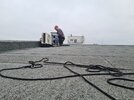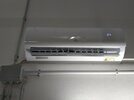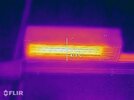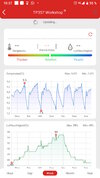ST1100Y
Site Supporter
Upon relocating to the "new" bike shop in '23, we soon found that its getting pretty hot in there during the summer; roof is made of prefabricated concrete slabs, sealed with Bitumen rolls...
So in '24 I came across a really decent offer for a 12,000Btu split-set, R32, infrared remocon, heat/cool... € 399,-... (despite working in that trade, I'd never gotten one that cheap at my workplace...)
Installation done in about 2 hours, 1/4" & 3/8" pipes, flare connections, interconnecting & supply cables, drawing vacuum, etc... (still got all the tools...)
So the summer was comfy and cool, 25°C and low humidity, with no issue... once it got colder in fall, depress HEAT, comfy again... and way more efficient then the electric blower heater...



Turns out it even features a "frost protection mode", fixing the set-temp to 8°C/46°F by depressing the ECO button for >5 seconds... cool!
To confirm what its actually doing there, I obtained a small temperature logger:

Working flawless!
So in '24 I came across a really decent offer for a 12,000Btu split-set, R32, infrared remocon, heat/cool... € 399,-... (despite working in that trade, I'd never gotten one that cheap at my workplace...)
Installation done in about 2 hours, 1/4" & 3/8" pipes, flare connections, interconnecting & supply cables, drawing vacuum, etc... (still got all the tools...)
So the summer was comfy and cool, 25°C and low humidity, with no issue... once it got colder in fall, depress HEAT, comfy again... and way more efficient then the electric blower heater...



Turns out it even features a "frost protection mode", fixing the set-temp to 8°C/46°F by depressing the ECO button for >5 seconds... cool!
To confirm what its actually doing there, I obtained a small temperature logger:

Working flawless!

